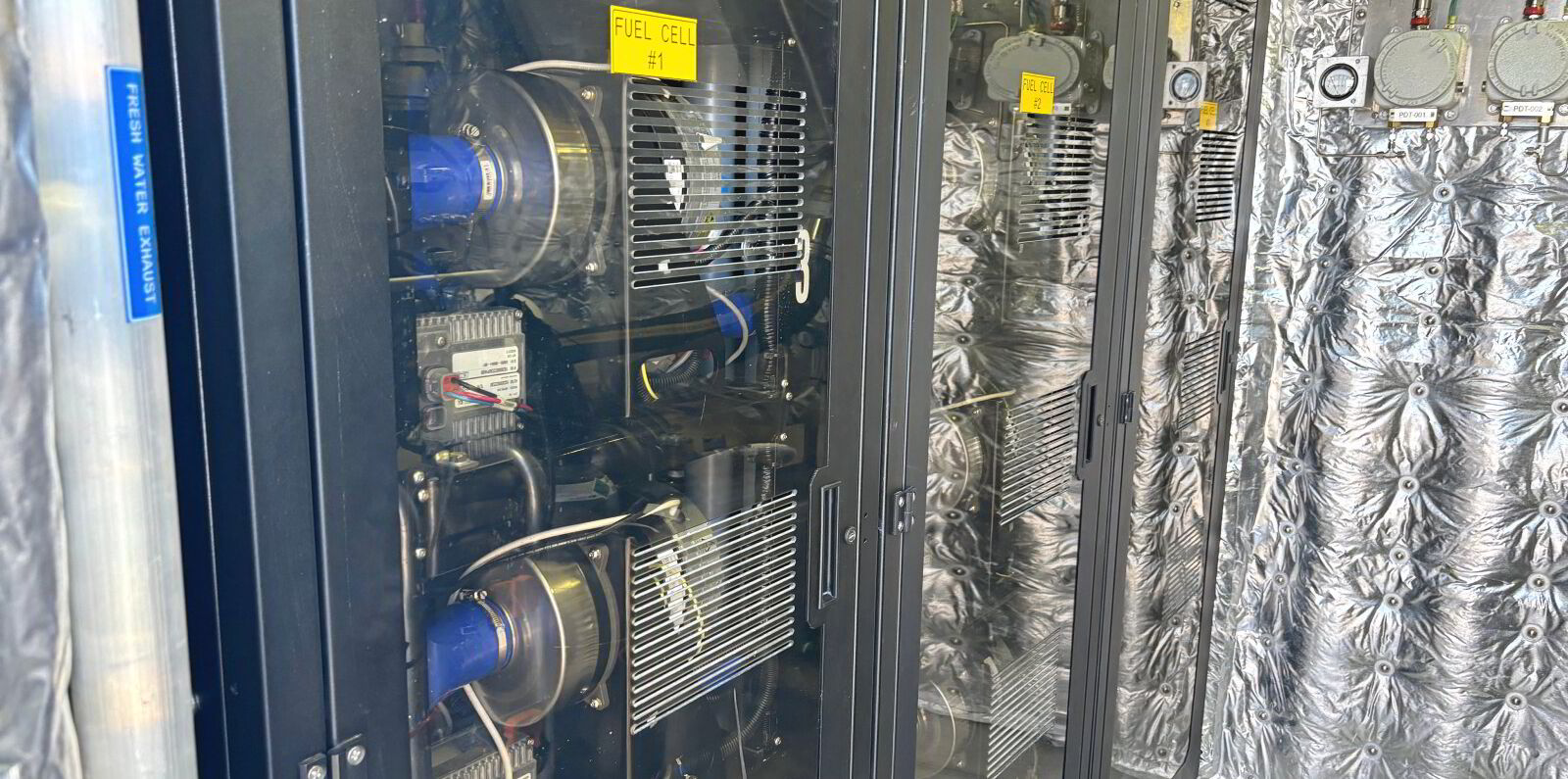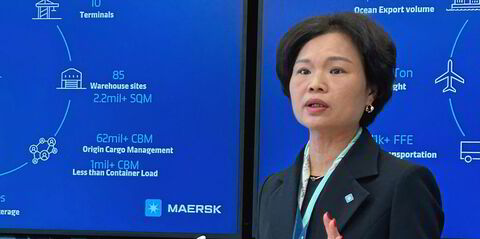As a unique vessel was charging its batteries at a historic San Francisco shipyard before fuelling with compressed hydrogen, water vapour could be felt on its upper deck.
The 75-passenger ferry Sea Change is the first in the US to use zero-emission hydrogen. Despite the term, it does emit warm water vapour — and it is clean enough to drink.
This little vessel is about to start operating in the waters of San Francisco Bay in an attempt to bring zero-emission shipping to harbour craft in California and beyond.
Now that it has completed its long commissioning and permitting process since being built in 2021 at All American Marine, owner Switch Maritime is hoping it will lead to larger hydrogen-fuelled ferries.
Last month’s approval by the US Coast Guard for the vessel’s operation was a “massive, massive milestone” for the project, Switch Maritime chief executive Pace Ralli told TradeWinds’ Green Seas podcast.
“Now we get to go into public passenger service and take this technology to the next designs,” he said.
“We’re looking at 150-passenger, 300-passenger and larger harbour craft, where this technology can be applied and provide zero-emission propulsion.”
It has taken some time to get here. Switch Maritime and the vessel’s developer, Zero Emission Industries (ZEI), had to blaze a trail through the tough regulatory approval process required for pioneering a new technology.
The vessel has been gearing up to start operations by the end of this month.
The Sea Change can achieve speeds of up to 22 knots (nearly 41 km/h) and with its combination of batteries and hydrogen fuel cells, its lack of greenhouse gas emissions is an important achievement in California, where the state government wants harbour craft to have no emissions at all.

The Coast Guard approval is a key step, as there was no regulatory precedent for a hydrogen-fuelled vessel in the US before ZEI began developing the ferry. This lack of precedent contributed to the longer-than-expected approval process.
The approval paves the way for future hydrogen-fuelled vessels.

Ralli said securing Coast Guard approval is not the finish line, but a starting point.
“The starting line is taking this technology and continuing to put it into vessels that are useful to ferry operators and harbour craft operators around the US…” he said.
“We can grow from that precedent, now that we have policy in place with the Coast Guard. So we’ve come a long way in five years, and I think there’s a lot more we could start building.”
Hydrogen-fuelled vessel development will also be helped by the International Maritime Organization’s International Code of Safety for Ships Using Gases or Other Low-flashpoint Fuels. Known as the IGF Code, it entered force in 2017, and hydrogen guidelines are due this year.
Ralli said Switch Maritime is focusing on hydrogen and batteries to achieve a fully zero-emissions technology. And to establish a zero-emissions economy, he said, the strategy must be deploy, deploy, deploy.
While the Sea Change may be zero emissions on a tank-to-wake basis, examining the supply chain reveals the presence of greenhouse gas emissions.

But Ralli said his company is working with the local port to develop an electrolyser — technology that turns electricity into hydrogen. For a fully zero-emission footprint, Switch Maritime wants to use electricity sourced from the Hetch Hetchy hydroelectric plant, which provides power to San Francisco from a reservoir in Yosemite National Park.
That is a long-term plan, however, that requires more of these vessels on the water to make producing green hydrogen viable.
Ralli said Switch Maritime would like to continue building for San Francisco, where the city values green projects, and California’s zero-emission mandate for certain harbour craft provides further regulatory support.
“We very much would like to be working on some of the other major ferry markets in the US — New York City, Seattle, Boston and others — that we think will be following to some degree what San Francisco is doing in their transition,” he said.
“I don’t think it’s happening next year in those other cities, but it seems to be trending in that direction. So I imagine we’ll be taking designs we’re proving out in this market and then applying them to other markets around the US.”
The Sea Change project is in part an exercise in figuring out how much it costs to build, fuel and operate a hydrogen-powered vessel.

Switch Maritime estimates that a hydrogen ferry costs about 40% more than a conventional vessel. But that should change, and Ralli calculates that cost parity could come in 2035.
After all, there have been big advances in fuel cells since ZEI began working on the Sea Change. Chief executive Joe Pratt mentioned that when ZEI began looking at hydrogen fuelling for vessels in 2014, the Toyota Mirai, the first mass-produced hydrogen car, was not on the market yet.
- Ship type: Passenger ferry
- Capacity: 75 passengers
- Length overall: 72 feet (21 metres)
- Beam: 24 feet
- Max speed: 22 knots (41.7 km/h)
- Cruising speed: 15 knots
- Range: 300 nautical miles (555 km)
Toyota and others have made big strides in hydrogen fuel cell technology since 2017, when key design decisions were made about the Sea Change. Now, fuel cells are cheaper, take up less space and are more powerful.
“In a nutshell, there’s been a huge amount of technical development in reducing the size and weight of the fuel cell systems, while increasing the power output,” Pratt said.
“There’s also been big strides in reliability and robustness to be able to translate these fuel cells from niche applications to more mainstream, where they’re required to run thousands of hours a year.”
Another ZEI project involves a fuel cell on an 8.2-metre power boat that can operate at 40 knots.

For the San Francisco-based ZEI, that is an opportunity to build fuel cells for other kinds of marine operations.
For Switch Maritime, that means its next ferry can operate at faster speeds and carry twice as many passengers — making it more competitive with existing designs.
What lessons can be learned from this project to put more hydrogen-fuelled vessels on the water?
Although the Sea Change took longer than expected to get approved, Pratt and Ralli made no complaints about the Coast Guard, which they described as an excellent partner that wants green technologies to succeed.
But the agency has a lot on its plate amid an abundance of new technologies.
“They’re super short-staffed and underfunded, and so they have a huge challenge, especially when it comes to evaluating the new technology and how to do it in the right way, how to get up to speed [and] how to get their own people experts on these technologies so they can have the correct regulatory framework,” Pratt said.

Ralli believes more resources for the Coast Guard could help smooth the regulatory pathway.
Another lesson was that many shipyards are not typically equipped to work with high-pressure hydrogen or high-voltage electrical components for a vessel like this.
Pratt said ZEI realised the need for fuel cell power systems that can be easily installed in a shipyard — the product the company is focused on making today.
Another key need to move this technology forward is contracts from ferry operators that are long enough to support the construction of a new vessel.
“What’s going to determine how quickly we can roll out zero-emission vessels into the fleets around the US — and this goes for globally as well — is the contracts that you can get for them, or bankable commitments that you can get for zero-emissions assets,” Ralli said, as the Sea Change’s vent mast made a Star Wars-like sound that is common during fuelling.
Whether it is a bareboat lease or other charter arrangement, those contracts have to be enough to finance a vessel.
“That’s a really … big gap,” he said.






